Neuphony’s Guide to Understanding Brainwaves
By following these steps and adhering to the professional considerations, you can leverage the power of EEG analysis to gain valuable insights into brain function, optimize cognitive performance, and inform evidence-based interventions for individuals seeking to improve their mental well-being.
Setting Up Device
Connecting Sensors On Scalp
- Ensure a snug fit of the cap/headband by tightening the straps securely. b. Connect reference sensors, confirming their activation on the desktop app. c. Proceed to connect remaining sensors by either adjusting the headband or twisting sensors on the FlexCap.
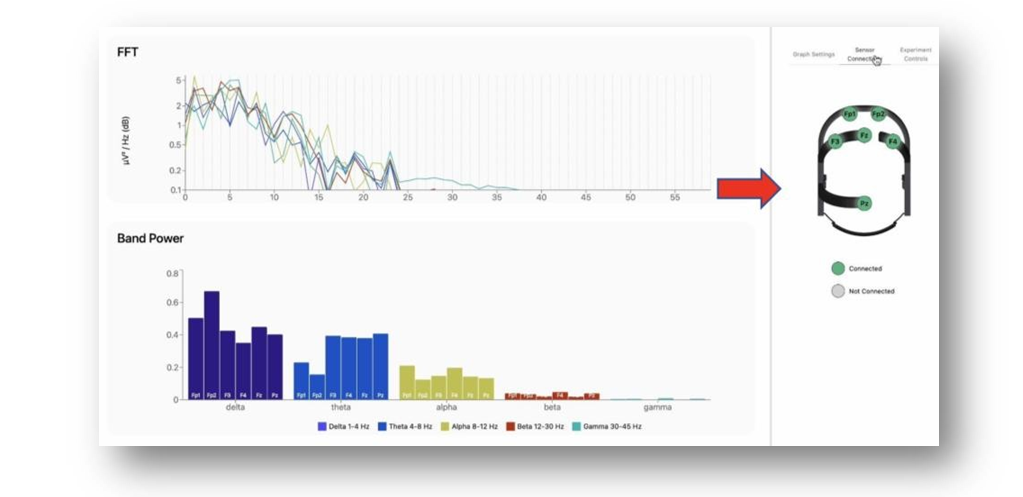
Ensuring Robust Sensor Connection
A) On the ‘Raw Data’ screen, configure ‘Graph Settings’ as follows:
- Amplitude Scale (μVp-p): 100
- Time Scale (sec): 10
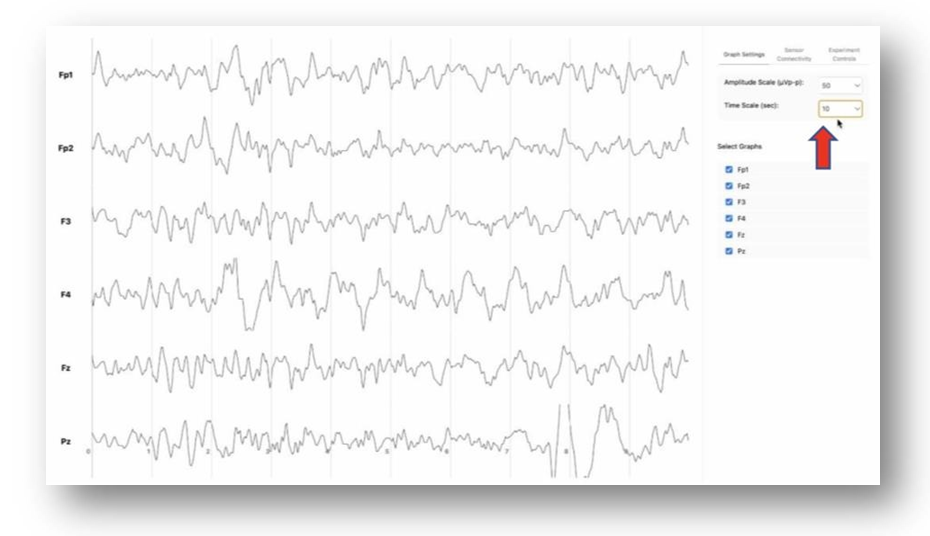
Understanding & Identifying Anomalies
Several anomalies may compromise the quality of EEG data collected from dry sensors. Identifying and addressing these anomalies is imperative for accurate interpretation.
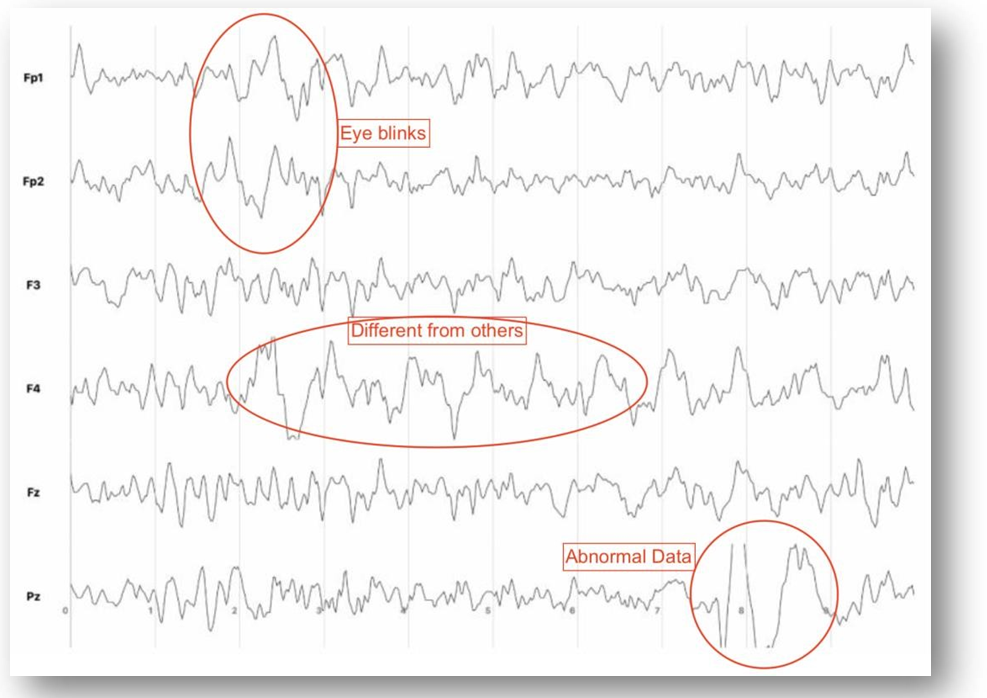
Poor Contact
- Incomplete contact between sensor and scalp, leading to low signal amplitude and high impedence
- Flat or noisy signals compared to nearby
- Visible air gaps between the sensor and the scalp.
Skin Movement
Scalp or hair movement due to participant activity, muscle engagement, or perspiration
- High-frequency noise
- Erratic fluctuations in signal amplitude.
Interference
External electrical noise from sources like power lines, computers, or electronic devices
- Consistent 50/60Hz hum in the
- Spikes or bursts of noise unrelated to brain
Sensor Malfunction
Hardware failure or sensor
- Complete absence of signal from a specific
- Erratic or distorted signals differing from other
Additional Checks
- Identify flat lines on Fp1 and Fp2 These could possibly indicate eye blinking.
- Ensure consistency in graphs between corresponding sensors on the left and right
Data Analysis
Baseline Assessment
- Preparation: Ensure the subject is seated comfortably with closed eyes for 2-4 minutes, minimizing movement or mental effort
- Data Acquisition: Commence EEG recording, utilizing Fast Fourier Transform (FFT) analysis in Relative and Histogram mode to assess the relative power of Delta, Theta, Alpha, Beta, and Gamma frequency bands.
- Channel Analysis: Identify channels with significant bandwave power deviations, focusing on relative differences for potential imbalances.
Identifying Abnormalities
- Interchannel Variability: Identify pronounced discrepancies in bandwave power between channels, suggesting deviations from normal functional connectivity.
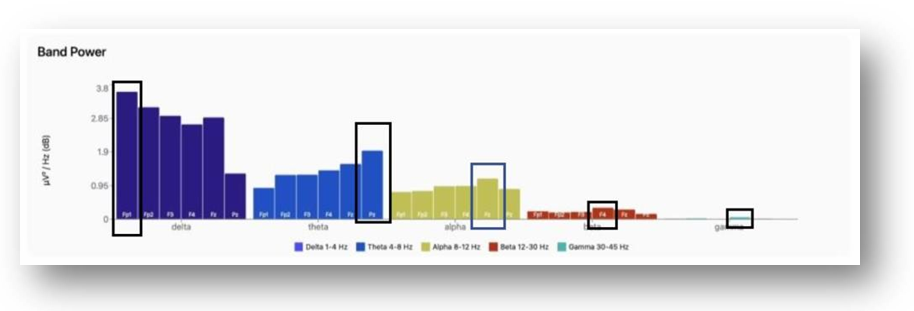
- Intrachannel Extremes: Examine individual channels for unusually high or low activity within specific frequency bands, considering associated functions
- Visual Interpretation: Analyze graphed data for deviations, indicating hyperactivity or hypoactivity, highlighting potential areas of dysfunction.
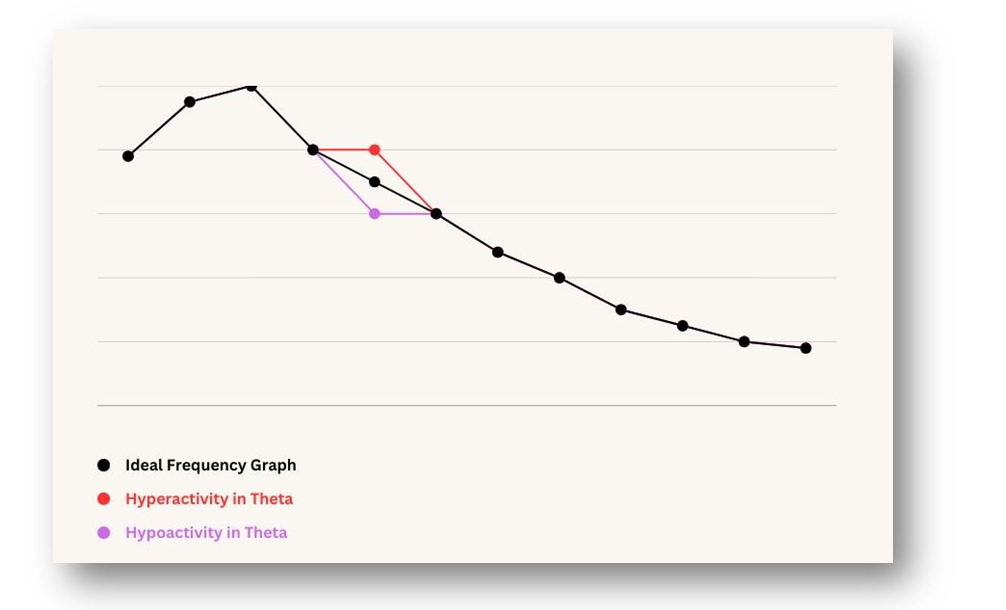
Mapping & Action Planning
- Functional Localization: Refer to the Brodmann Area chart to correlate identified bands and channels with specific brain regions and
| Site | Brodmann Area | Brain Function |
| Fpz | 10 (11) | Poor Response Inhibition Ventro Medial Forebrain Bundle – Emotional Inhibition |
| Fp1 | 10 (11, 46) | Verbal, Episodic Retrieval Visual Working Memory |
| Fp2 | 10 (11, 46) | Face & Object Processing – Emotional Inhibition, Verbal Episodic Memory |
| F7 | 45 (38, 44, 46) | Visual & Auditory Working Memory BA 46 Divided & Selective Attention Broca’s Area – Semantic Short- Term Buffer |
| F8 | 47 (10, 46, 45) | Working & Visual / Spatial Memory (Short Term Buffer) Face Processing, Emotional Processing, Sustained Attention BA 45 |
| F3 | 8, 9 (46, 45, 44, 11, 8) | Verbal Episodic Retrieval, Object Processing Emotional Interpretation (Some Facial Recognition) Poor Response Inhibition – BA 9 |
| F4 | 8, 9 (46, 45, 44, 11, 8) | Verbal Episodic Retrieval, Semantic Retrieval – BA 8 Sustained & Selective Attention – BA 8 Vigilance Area, Impulse Control |
| Fz | 8, 9 | Anterior Cingulate, Internal vs External Attention – Most Active During Internal Attention Processing Personality Changes |
| C3 | 4, 3 (6, 5, 7, 40) | Sensory Motor Functions Short Term Memory – BA 40 |
| Cz | 4, 3, 12 | Basal Ganglia (Thalamic Efferent VA) Substantia Nigra (Thalamic Efferent VL) |
| C4 | 4, 3, (6, 5, 7, 40) | Sensory & Motor Functions Short Term Memory – BA 40 |
| T3 | 21 (22, 20, 52, 38) | Language Comprehension – BA 22, Inner Voice Wernicke’s Area, Declarative Memory Long Term Memory – Amygdala / Hippocampal Area |
| T4 | 21 (22, 20, 52, 38) | Personality – BA 21, 38 Categorization & Organization Auditory Cortex – Music Processing |
| T5 | 37 (21, 22, 39, 19) | Short-Term Memory – BA 37, Inner Voice Angular Gyrus – Meaning Construction |
| T6 | 37 (21, 22, 39, 19) | Long-Term Memory – BA 21, Facial Recognition – Emotional Content |
| P3 | 7 (39, 40, 19, 7) | Acalcula – BA 39 Angular Gyrus – Meaning Construction |
| Pz | 7 (5,19) | Agnosia, Apraxia – BA 7 Attentional Shifting Area – Perseverance |
| P4 | 7 (5,19) | Visual – Spatial Sketch Pad, Vigilance |
| O1, O2 | 18 (19) | Visual Processing, Procedural Memory, Dreaming |
| Oz | 17 (18, 19) | Visual Processing Hallucinations |
- Tailored Interventions: Develop targeted interventions based on Brodmann Area findings, incorporating cognitive training, behavioral modifications, or evidence-based
- Alternative Approach: Consult the provided table linking hyperactive bands and channels to recommended actions for quick
| Sensor Location | Dominating Brainwaves | Recommendation |
| Pz | Beta | Guided Meditation |
| Fz | Beta | Breathing techniques or neurofeedback from mobile application |
| Pz | Alpha | Theta Meditation (deep relaxation) or Self-Reflective meditation (mindfulness). Also try neurofeedback as volume will increase when Pz has alpha. |
| Fz | Alpha | Music Therapy, Body Scan |
| Pz | Theta | Chanting (compassion building) |
| Fz | Theta | To increase focus – real time neurofeedback from mobile application. |
| Fp2 & Fp4 | Beta | Quizes, games, puzzles (Goal will be to Build analytical processing) |
| Fp1 & Fp3 | Beta | Chanting, transcendental meditation |
| Fp2 & Fp4 | Alpha | Mindfulness (if we want to process emotions) Theta Meditation (deep relaxation) |
| Fp1 & Fp3 | Alpha | Chanting (deep relaxation or compassion) Quizes, puzzles, guided meditation (Gaining attention and coming back to moment) |
| Fp2 & Fp4 | Theta | If goal is emotional processing, then guided meditation |
| Fp1 & Fp3 | Theta | If goal is improved focus, then breathing and coming back to moment |
PDR Value
- Below 8 suggests sleep deprivation or requires a doctor’s
- Above 12 indicate hyperactivity, also requiring a doctor’s
- 11-12 imply highly stimulated maybe through pain killer or Caffeine,
Beyond The Baseline
- Task-Specific Recordings: Introduce tasks like reading, mental imagery, or emotional recall after capturing the baseline to observe adaptive changes in brainwave activity
- Dynamic Functional Mapping: Compare task-related EEG data to the baseline to identify areas of increased or decreased activity, providing insights into individual brain networks and dynamic interactions.

